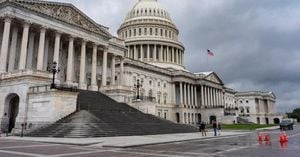On September 28, 2025, the Trump administration signed a sweeping tax breaks and spending cuts bill that is already reshaping the landscape for millions of Americans who rely on federal support for higher education and health care. The new law, which aims to curb government spending and tackle the ballooning national student loan debt, also sets in motion a series of deep cuts to Medicaid, the nation’s largest health insurance program for low-income and disabled individuals. These changes are sending ripples through families, students, health care providers, and educational institutions across the country, with the effects especially pronounced in states like North Carolina and Idaho.
For years, the cost of a college education in the United States has been climbing at a pace that far outstrips inflation. According to The Conversation, the average annual cost for tuition, fees, room, and board at a four-year college reached $30,884 in the 2022-23 academic year. In-state students at public institutions paid an average of $9,750 in tuition alone, while their counterparts at private nonprofit colleges faced a hefty $38,421 bill. These numbers stand in stark contrast to those in 42 other countries with reliable education data, where tuition is often dramatically lower—or even free, as in Sweden and Saudi Arabia.
To help families shoulder these costs, the U.S. government has traditionally relied on a patchwork of federal grants, loans, and work-study programs, all administered by the Department of Education. Pell Grants, first awarded in 1973, are the cornerstone of this system, providing need-based aid that does not require repayment. In the 2019-20 school year, about 40% of the nation’s 17 million undergraduates received federal grants—mostly Pell Grants—while 34% of undergraduates and 39% of graduate students took out federal loans.
But the new law brings significant changes. While it slightly expands eligibility for Pell Grants, it also introduces tighter limits on federal student borrowing. The goal, according to supporters of the bill, is to slow the national student loan spiral, which has seen federal student debt soar by 500% over the past two decades to a staggering $1.6 trillion. Under the new rules, undergraduates can still borrow up to roughly $10,000 per year in federal direct loans, and graduate students up to $20,500 per year. However, the lifetime borrowing limit for graduate students is now capped at $100,000, down from $138,500, with an exception for professional degrees—such as law and medicine—where the cap is set at $200,000. The PLUS Loans program for graduate students, which previously served about 11% of graduate students and 40% of those seeking professional doctorates, has been eliminated.
Perhaps the most headline-grabbing innovation is the introduction of the Workforce Pell Grant, set to launch on July 1, 2026. This new grant will provide small amounts of Pell funding for students pursuing short-term retraining programs of eight to 15 weeks, even if they already hold a bachelor’s degree. The aim is to help workers stay current in a fast-changing labor market, especially as artificial intelligence and federal layoffs contribute to rising long-term unemployment among the college-educated. A House appropriations bill has even proposed renaming these as “Trump Grants,” though Congressional approval is still pending.
While Pell Grant funding remains steady for now—the maximum award for the 2025-26 school year holds at $7,395—the law introduces a crucial change for part-time students. Their Pell Grant limits will now be pro-rated, or reduced, based on their enrollment status. This could make higher-priced colleges unaffordable for part-timers, forcing some to choose between enrolling full time or seeking out lower-tuition programs. As The Conversation notes, these shifts may push students away from private colleges toward in-state public institutions, and from part-time to full-time study. Colleges themselves may respond by cutting programs, services, and amenities to stay competitive and affordable.
Yet, even as the federal government tweaks its approach to higher education funding, the most immediate and painful effects of the new law are being felt in the health care sector—specifically, Medicaid. Medicaid is a lifeline for more than 80 million Americans, providing health coverage for low-income families, people with disabilities, and the elderly. But with the Trump administration’s law slashing federal Medicaid spending by about $1 trillion over the next decade, states are scrambling to fill the gap.
North Carolina and Idaho are among the first to implement cuts. North Carolina’s Medicaid agency announced that, starting October 1, 2025, all providers treating Medicaid patients will see at least a 3% reduction in payments. Primary care doctors face an 8% cut, and specialists a 10% reduction, according to KFF Health News. For families like that of Alessandra Fabrello in Chapel Hill, the impact is immediate and personal. Fabrello’s son, Ysadore Maklakoff, has complex medical needs requiring around-the-clock care. “When you say, ‘We’re just cutting provider rates,’ you’re actually cutting access for him for all his needs,” Fabrello told Truthout. Already, her son’s dentist has said the office will stop accepting Medicaid patients come November, and services like occupational and speech therapy, nursing, and respite care are becoming harder to secure.
Shannon Dowler, former chief medical officer for North Carolina Medicaid, warned that reduced payments will drive providers out of the Medicaid network, leading to “an immediate loss of access to care, worse outcomes, and cause higher downstream costs.” More than 3 million North Carolinians depend on Medicaid, and the state projects a loss of $23 billion in federal Medicaid funds over the next decade. In July, state lawmakers approved a mini budget that left the Medicaid agency $319 million short of its request, forcing pay cuts rather than eliminating optional program components. “The cut in the budget is absolutely the opposite direction of where we really want to go, need to go, have been headed as a state,” said Jay Ludlam, North Carolina’s deputy secretary for Medicaid.
Idaho, with about 350,000 Medicaid enrollees, has also slashed provider pay rates by 4% to address an $80 million budget shortfall. The Idaho Hospital Association’s Toni Lawson told KFF Health News that the financial strain is most acute at small rural hospitals, some of which have less than two days’ cash on hand for payroll. “Hopefully, none of them will close,” Lawson said, but she expects labor and delivery and behavioral health units—often money-losing services—to be the first on the chopping block. Several rural hospitals have already closed their labor and delivery units in the past year.
Nationwide, Medicaid accounts for about 19% of state general fund spending, second only to K-12 education, according to Brian Sigritz of the National Association of State Budget Officers. While states enjoyed strong revenue growth in 2021 and 2022, thanks in part to federal pandemic aid, that support has dried up even as costs for Medicaid, housing, and education continue to rise. Some states have responded by cutting income and property taxes, further squeezing budgets as they try to balance competing priorities.
For families like Fabrello’s, the stakes couldn’t be higher. She has been unable to work outside the home, her savings nearly depleted, and only recently began receiving compensation for her caregiving duties. Now, with looming pay cuts, she faces renewed financial uncertainty. “As parents, we are indispensable lifelines to our children, and we are struggling to fight for our own survival on top of it,” she said.
The Trump administration’s new tax-and-spending law is reshaping the social safety net in profound ways. As states and families grapple with its consequences, the coming months will reveal whether the intended cost savings can be achieved without sacrificing access to education and health care for those who need it most.






